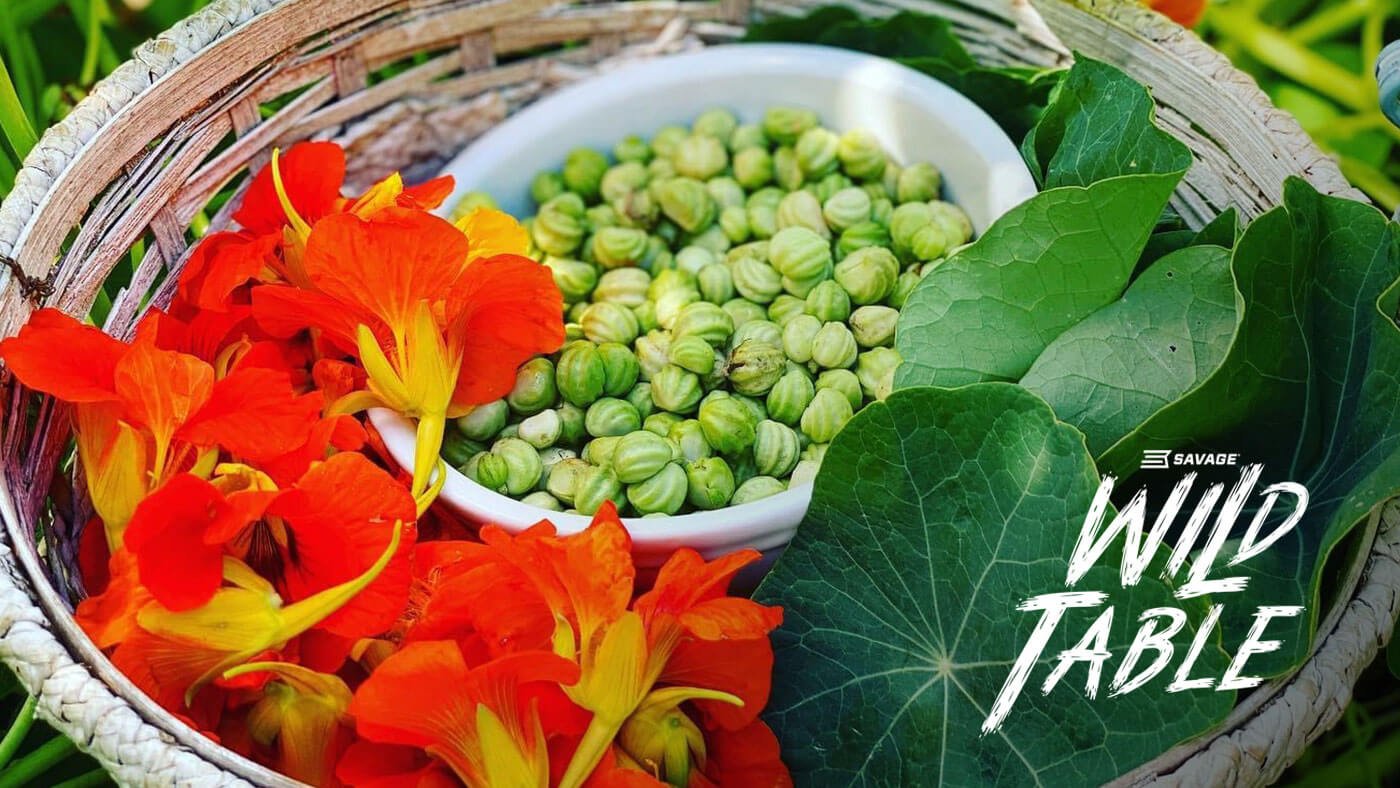- Savage Blog
- Edible Flowers? 4 Ways to Cook with Nasturtiums | Wild Table
Edible Flowers? 4 Ways to Cook with Nasturtiums | Wild Table

Nasturtiums (nuh-STUR-shm) are one of the first seeds I plant when the weather allows. My taste buds anticipate the fiery-flavored leaves, and I imagine seeing their beauty flourish all around the farm as I sow them into the ground. There is so much more to tell about the limitless magic of Nasturtiums.
Nasturtium – Tropaeolum majus
Botanically known as Tropaeolum majus, the entire plant is not only visually striking but also a staple in my medicinal plant repertoire. Once established, they boast brightly colored flowers in various hues and vibrant green leaves, with some varieties exhibiting unique camo-like patterns in cream and green variations. Beyond their aesthetics, nasturtiums offer a wealth of culinary and medicinal uses.

Culinary Delights
The flowers and leaves of nasturtiums are entirely edible and make a flavorful addition to salads, stir-fries, or pesto. The seeds, once pickled, can serve as a delightful alternative to capers and are perfect for crafting flavorful vinegars to enhance salads or create brines for roasts. Nasturtiums also double as an antiseptic for wounds and contribute to immune system support.

Garden Guardians
In the garden, nasturtiums shine as natural pest deterrents. Acting as trap crops, they ward off pests from other plants, especially aphids. Their irresistible allure even attracts cabbage moths, a boon for safeguarding cabbage, kale, broccoli, and other brassicas. Nasturtiums also draw in beneficial insects like hoverflies to feast on aphids, creating a balanced ecosystem. However, it's crucial to savor these benefits only after ensuring the plants aren't besieged by pests themselves.
Medicinal Marvels
For those acquainted with nasturtium's intense pepper-like bite, it's this very characteristic that underlines its major medicinal actions. Rich in volatile oils like limonene found in stems, seeds, and leaves, nasturtiums wield potent antibacterial, anti-inflammatory, and antioxidant properties. A poultice made from nasturtium leaves can serve as an antiseptic for wounds, while ground-up seeds can form a paste to combat fungal infections. Historically, nasturtium flowers and leaves were even administered to cure scurvy due to their high vitamin C content.
Favorite Uses
Setting aside the myriad of facts about nasturtiums, my preferred utilization of these flowers lies in pickling their seeds, akin to capers. Crafting infused butter, vinegar and pesto comes in as a close second; all these applications capture the essence of nasturtium's distinctive flavor profile. By integrating nasturtiums into both my garden and kitchen, I not only elevate the visual appeal, but also infuse my meals with a burst of flavor and harness their natural medicinal properties. Truly, nasturtiums are a multi-faceted gem in the realm of both gardening and creating beautiful condiments!
Nasturtium Recipes!
Nasturtium Capers

Capers crafted from nasturtium seeds are a pickled delight!
Ingredients:
- 2/3 cup nasturtium seed pods
- 1/4 cup salt
- 2 cups water
- 2/3 cup distilled white vinegar (5% acidity)
- 1 teaspoon sugar
- 1 bay leaf (optional)
- Garlic cloves (optional)
Preparing Your Pickled Nasturtium Pods:
Harvest young, light green, half-ripened seed pods while they’re still on the vines. These pods are crisp and juicy, having optimal flavor. Be mindful that as they mature, they tend to lose their zest and eventually transform into wrinkled brown seeds that drop to the ground.
Separate the pods into individual seeds and give them a quick rinse to remove any dirt.
The raw seeds are rich in potent mustard oils, making them intensely flavorful. To temper their strength, start by mellowing them out in a simple salty brine.
In a quart jar, dissolve the salt in water. Add the nasturtium seeds, then cover the rim with a zip-top bag or a fermenting weight, pushing it down into the jar to ensure the seeds remain submerged. Allow the brine to sit for a couple of days at room temperature, during which the seeds will take on a dull green hue.
Strain the seeds and rinse them again to remove excess salt.
In a small saucepan over medium-high heat, bring the vinegar and sugar to a low boil for 1 minute, stirring to dissolve the sugar.
Divide the seeds into half-pint jars, then pour the hot vinegar over the seeds, ensuring they are completely covered. Add a bay leaf and garlic to each jar.

Let the jars cool to room temperature before sealing them with lids. At this point, you have the option to either store the jars at room temperature (without the need for a boiling water bath) or in the fridge.
The pickled pods will keep indefinitely in the vinegar. I still have a jar from a large batch made almost two years ago, safely stored in my pantry. Besides using them onto of a salad, they make a mouthwatering Nasturtium butter to use on your favorite grilled meat!
Nasturtium Butter
Ingredients:
- 1/2 cup nasturtium capers (pickled nasturtium seeds)
- 1 cup unsalted butter, softened
- 2 teaspoons lemon juice
- 1 teaspoon lemon zest
- Salt and pepper to taste
Instructions:
In a food processor (or blender), combine nasturtium capers, softened butter, lemon juice, and lemon zest.
Pulse the ingredients until well blended and the capers are finely chopped.
Taste the butter and season with salt and pepper as desired. Remember that the capers already contribute a salty and tangy flavor, so adjust the seasoning accordingly.
Continue blending until the mixture achieves a smooth consistency.
Transfer the nasturtium caper butter to a bowl or shape it into a log using parchment paper for easy slicing.
Refrigerate the butter for at least 30 minutes to allow the flavors to meld.
This unique and zesty nasturtium butter will elevate other dishes as well with its peppery undertones and distinctive flavor profile.
Nasturtium Pesto

Ingredients:
- 2 cups fresh nasturtium leaves and tender stems
- 1/2 cup nasturtium flowers (optional, for added color)
- 1/2 cup grated Parmesan cheese
- 1/2 cup pine nuts or walnuts
- 2 cloves garlic, peeled
- 1 cup extra-virgin olive oil
- Salt and pepper to taste
- Zest and juice of 1 lemon (optional, for brightness)
Instructions:
Rinse the nasturtium leaves, stems, and flowers thoroughly under cold water, and pat them dry with a clean kitchen towel.
In a food processor (or blender), combine nasturtium leaves, flowers, Parmesan cheese, pine nuts (or walnuts), and garlic.
Pulse the ingredients until coarsely chopped.
With the food processor running, slowly pour in the olive oil until the mixture reaches your desired consistency.
Season the pesto with salt and pepper to taste. If you'd like to add a hint of brightness, add the zest and juice of one lemon.
Continue blending until the pesto reaches a smooth and creamy texture.
Taste and adjust the seasonings, adding more salt, pepper, garlic, or lemon juice as needed.
Transfer the pesto to a jar or airtight container and store it in the refrigerator or freezer to enjoy during the winter months!
Enjoy this vibrant and peppery nasturtium pesto on pasta, sandwiches, salads, or as a flavorful topping for grilled meats or vegetables.
Nasturtium Infused Vinegar

Ingredients:
- 1 cup nasturtium flowers and leaves, washed and dried
- 2 cups white wine vinegar or apple cider vinegar
- Sterilized glass jar with a tight-fitting lid
Instructions:
Clean and thoroughly dry flowers and leaves
In the sterilized glass jar, layer the nasturtium flowers and leaves.
Heat the vinegar in a saucepan until warm, NOT boiling.
Pour the warm vinegar over the nasturtium flowers and leaves in the jar, ensuring they are fully submerged.
Use a clean spoon to press down on the flowers and leaves, releasing any air bubbles and ensuring they are covered by vinegar.
Seal the jar tightly with the lid.
Place the jar in a cool, dark place for about two weeks to allow the flavors to infuse. Shake the jar gently every few days to help distribute the flavors.
After two weeks, strain the infused vinegar through a fine-mesh sieve or cheesecloth into a clean, sterilized bottle.
Discard the nasturtium flowers and leaves- my chickens love these!
Seal the bottle and store the nasturtium-infused vinegar in the refrigerator for an extended shelf life.
Nasturtium-infused vinegar adds a unique, peppery flavor to salad dressings, marinades, or as a vibrant splash in various recipes.
Are you a field to table foodie? Check out more of our wild game recipes and foraging tips on our Wild Table blog!

